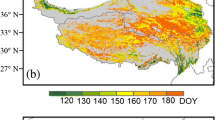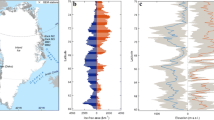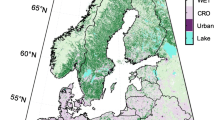Abstract
Land surface phenology is widely retrieved from satellite observations at regional and global scales, and its long-term record has been demonstrated to be a valuable tool for reconstructing past climate variations, monitoring the dynamics of terrestrial ecosystems in response to climate impacts, and predicting biological responses to future climate scenarios. This study detected global land surface phenology from the advanced very high resolution radiometer (AVHRR) and the Moderate Resolution Imaging Spectroradiometer (MODIS) data from 1982 to 2010. Based on daily enhanced vegetation index at a spatial resolution of 0.05 degrees, we simulated the seasonal vegetative trajectory for each individual pixel using piecewise logistic models, which was then used to detect the onset of greenness increase (OGI) and the length of vegetation growing season (GSL). Further, both overall interannual variations and pixel-based trends were examined across Koeppen’s climate regions for the periods of 1982–1999 and 2000–2010, respectively. The results show that OGI and GSL varied considerably during 1982–2010 across the globe. Generally, the interannual variation could be more than a month in precipitation-controlled tropical and dry climates while it was mainly less than 15 days in temperature-controlled temperate, cold, and polar climates. OGI, overall, shifted early, and GSL was prolonged from 1982 to 2010 in most climate regions in North America and Asia while the consistently significant trends only occurred in cold climate and polar climate in North America. The overall trends in Europe were generally insignificant. Over South America, late OGI was consistent (particularly from 1982 to 1999) while either positive or negative GSL trends in a climate region were mostly reversed between the periods of 1982–1999 and 2000–2010. In the Northern Hemisphere of Africa, OGI trends were mostly insignificant, but prolonged GSL was evident over individual climate regions during the last 3 decades. OGI mainly showed late trends in the Southern Hemisphere of Africa while GSL was reversed from reduced GSL trends (1982–1999) to prolonged trends (2000–2010). In Australia, GSL exhibited considerable interannual variation, but the consistent trend lacked presence in most regions. Finally, the proportion of pixels with significant trends was less than 1 % in most of climate regions although it could be as large as 10 %.










Similar content being viewed by others
References
Ahl DE, Gower ST, Burrows SN, Shabanov NV, Myneni RB, Knyazikhin Y (2006) Monitoring spring canopy phenology of a deciduous broadleaf forest using MODIS. Remote Sens Environ 104(1):88–95
Chen X, Hu B, Yu R (2005) Spatial and temporal variation of phenological growing season and climate change impacts in temperate eastern China. Glob Chang Biol 11:1118–1130
de Beurs KM, Henebry GM (2004) Land surface phenology, climatic variation, and institutional change: analyzing agricultural land cover change in Kazakhstan. Remote Sens Environ 89:497–509
de Beurs KM, Henebry GM (2005a) A statistical framework for the analysis of long image time series. Int J Remote Sens 26(8):1551–1573
de Beurs KM, Henebry GM (2005b) Land surface phenology and temperature variation in the IGBP high-latitude transects. Glob Chang Biol 11:779–790
de Jong R, de Bruin S, de Wit A, Schaepman ME, Dent DL (2011) Analysis of monotonic greening and browning trends from global NDVI time-series. Remote Sens Environ 115:692–702
Delbart N, Kergoat L, Le Toan T, Lhermitte J, Picard G (2005) Determination of phenological dates in boreal regions using normalized difference water index. Remote Sens Environ 97:26–38
Eidenshink JC (1992) The 1990 conterminous U.S. AVHRR data set. Photogramm Eng Remote Sens 58(6):809–813
Fisher A (1994) A model for the seasonal variations of vegetation indices in coarse resolution data and its inversion to extract crop parameters. Remote Sens Environ 48:220–230
Fisher JI, Mustard JF, Vadeboncoeur MA (2006) Green leaf phenology at Landsat resolution: scaling from the field to the satellite. Remote Sens Environ 100:265–279
Friedl MA, Henebry G, Reed B et al (2006) Land surface phenology: a community white paper requested by NASA.ftp://ftp.iluci.org/Land_ESDR/Phenology_Friedl_whitepaper.pdf
Groisman PYA, Knight RW (2008) Prolonged dry episodes over the conterminous United States: new tendencies emerging during the last 40 years. J Clim 21:1850–1862
Hargrove WW, Spruce JP, Gasser GE, Hoffman FM (2009) Toward a national early warning system for forest disturbances using remotely sensed canopy phenology. Photogramm Eng Remote Sens 75:1150–1156
Heumann W, Seaquist JW, Eklundh L, Jonsson P (2007) AVHRR derived phenological change in the Sahel and Soudan, Africa, 1982–2005. Remote Sens Environ 108(4):385–392
Hopkins AD (1938) Bioclimatics—a science of life and climate relations. US Department of Agriculture Misc. Publication No. 280. US Government Printing Office, Washington, DC
Huete AR, Didan K, Miura T, Rodriguez EP, Gao X, Ferreira LG (2002) Overview of the radiometric and biophysical performance of the MODIS vegetation indices. Remote Sens Environ 83:195–213
Huete AR, Didan K, Shimabukuro YE, Ratana P, Saleska CR, Hutyra LR et al (2006) Amazon rainforests green-up with sunlight in dry season. Geophys Res Lett 33, L06405. doi:10.1029/2005GL025583
IPCC (2007) Climate change 2007: impacts, adaptation, and vulnerability contribution of working group II to the fourth assessment report of the Intergovernment Panel on Climate Change, ed M L Parry, O F Canziani, J P Palutikof, P J van der Linden and C E Hanson (Cambridge: CambridgeUniversity Press) 976 pp
James ME, Kalluri SNV (1994) The Pathfinder AVHRR land data set: an improved coarse resolution data set for terrestrial monitoring. Int J Remote Sens Special Issue on Global Data Sets 15(17):3347–3363
Jiang Z, Huete AR, Didan K, Miura T (2008) Development of a two-band enhanced vegetation index without a blue band. Remote Sens Environ 112:3833–3845
Jönsson P, Eklundh L (2002) Seasonality extraction by function fitting to time-series of satellite sensor data. IEEE T Geosci Remote 40:1824–1831
Julien Y, Sobrino JA (2009) Global land surface phenology trends from GIMMS database. Int J Remote Sens 30(13):3495–3513
Justice CO, Vermote E, Townshend JRG et al (1997) The Moderate Resolution Imaging Spectroradiometer (MODIS): land remote sensing for global change research. IEEE Trans Geosci Remote Sens 36:1228–1249
Karlsen SR, Elvebakk A, Høgda KA, Johansen B (2006) Satellite based mapping of the growing season and bioclimatic zones in Fennoscandia. Glob Ecol Biogeogr 15:416–430
Kim Y, Huete AR, Miura T, Jiang Z (2010) Spectral compatibility of vegetation indices across sensors: band decomposition analysis with Hyperion data. J Appl Remote Sens 4:043520
Kogan F, Gitelson A, Zakarin E, Spivak L, Lebed L (2003) AVHRR-based spectral vegetation index for quantitative assessment of vegetation state and productivity: calibration and validation. Photogramm Eng Remote Sens 69(8):899–906
Kovalskyy V, David P, Roy DP, Zhang X, Ju J (2012) The suitability of multi-temporal web-enabled Landsat data NDVI for phenological monitoring—a comparison with flux tower and MODIS NDVI. Remote Sens Lett 3(4):325–334
Lauscher F (1978) Neue Analysen ältester und neuerer phänologischer Reihen. Arch Met Geophysik Klimatol (B) 26:373–385
Liang L, Schwartz MD, Fei S (2011) Validating satellite phenology through intensive ground observation and landscape scaling in a mixed seasonal forest. Remote Sens Environ 115:143–157
Lloyd D (1990) A phenological classification of terrestrial vegetation cover using shortwave vegetation index imagery. Int J Remote Sens 11:2269–2279
Lotsch A, Friedl MA, Anderson BT, Tucker CJ (2003) Coupled vegetation-precipitation variability observed from satellite and climate records. Geophys Res Lett 30(14). doi:10.1029/2003GL017506
Moulin S, Kergoat L, Viovy N, Dedieu G (1997) Global-scale assessment of vegetation phenology using NOAA/AVHRR satellite measurements. J Climate 10(6):1154–1170
Myneni RB, Keeling CD, Tucker CJ, Asrar G, Nemani RR (1997) Increased plant growth in the northern high latitudes from 1981–1991. Nature 386:698–702
Olson DM, Dinerstein E, Wikramanayake ED, Burgess ND, Powell GVN, Underwood EC, D’Amico JA, Itoua I, Strand HE, Morrison JC, Loucks CJ, Allnutt TF, Rick-etts TH, Kura Y, Lamoreux JF, Wettengel WW, Hedao P, Kassem KR (2001) Terrestrial ecoregions of the world: a new map of life on Earth. Bioscience 51(11):933–938
Olsson L, Eklundh L, Ardö J (2005) Greening of the Sahel—trends, patterns and hypotheses. J Arid Environ 63:556–566
Pedelty J, Vermote EF, Devadiga S, Roy D, Schaaf C, Privette J et al (2007) Generating a long-term land data record from the AVHRR and MODIS instruments. Geoscience and Remote Sensing Symposium, 2007. IGARSS 2007. IEEE International. pp 1021–1025
Piao S, Fang J, He J (2006) Variations in vegetation net primary production in the Qinghai-Xizang Plateau, China, from 1982 to 1999. Clim Chang 74(1):253–267
Reader R, Radford JS, Lieth H (1974) Modeling important phytophenological events in eastern North America. In: Lieth H (ed) Phenology and Seasonality Modeling. Springer, New York, pp 329–342
Reed BC (2006) Trend analysis of time-series phenology of North America derived from satellite data. GIsci Remote Sens 43(1):24–38
Reed BC, Brown JF, VanderZee D, Loveland TR, Merchant JW, Ohlen DO (1994) Measuring phenological variablity from satellite imagery. J Veg Sci 5:703–714
Richardson AD, Bailey AS, Denny EG, Martin CW, O’Keefe J (2006) Phenology of a northern hardwood forest canopy. Glob Chang Biol 12:1174–1188
Richardson AD, Braswell BH, Hollinger D, Jenkins JP, Ollinger SV (2009) Near-surface remote sensing of spatial and temporal variation in canopy phenology. Ecol Appl 19(6):1417–1428
Rocha AV, Shaver GR (2009) Advantages of a two band EVI calculated from solar and photosynthetically active radiation fluxes. Agric For Meteorol 149(9):1560–1563
Rocha AV, Potts DL, Goulden ML (2008) Standing litter as a driver of interannual CO2 exchange variability in a freshwater marsh. J Geophys Res 113, G04020. doi:10.1029/2008JG000713
Shen M, Tang Y, Chen J, Zhu X, Zheng Y (2011) Influences of temperature and precipitation before the growing season on spring phenology in grasslands of the central and eastern Qinghai-Tibetan Plateau. Agric For Meteorol 151:1711–1722
Sparks TH, Carey PD (1995) The responses of species to climate over 2 centuries—an analysis of the Marsham phonological record, 1736–1947. J Ecol 83:321–329
Stöckli R, Vidale P (2004) European plant phenology and climate as seen in a 20-year AVHRR land-surface parameter dataset. Int J Remote Sens 25(17):3303–3330. doi:10.1080/01431160310001618149
Stowe LL, Davis PA, McClain EP (1999) Scientific basis and initial evaluation of the CLAVR-1 global clear cloud classification algorithm for Advanced Very High Resolution Radiometer. J Atmos Ocean Technol 16:656–681
Tateishi R, Ebata, M (2004) Analysis of phenological change patterns using 1982–2000 Advanced Very High Resolution Radiometer (AVHRR) data. Int J Remote Sens 25:2287–2300
Tsend-Ayush J, Miura T, Didan K, Barreto-munoz A (2012) Compatibility analysis of Spot-4 vegetation and terra modis vegetation index products for long-term data records. Proceedings of IEEE international geoscience and remote sensing symposium, 22–27 July 2012, Munich, Germany
Tucker CJ, Slaback DA, Pinzon JE et al (2001) Higher northern latitude normalized difference vegetation index and growing season trends from 1982 to 1999. Int J Biometeorol 45:184–190
Tucker CJ, Pinzon JE, Brown ME, Slayback D, Pak EW, Mahoney R, Vermote E, Saleous N (2005) An extended AVHRR 8-km NDVI data set compatible with MODIS and SPOT Vegetation NDVI data. Int J Remote Sens 26(20):4485–4498
Vermote EF, Kaufman YJ (1995) Absolute calibration of AVHRR visible and nearinfrared channels using ocean and cloud views. Int J Remote Sens 16(13):2317–2340
Vrieling A, de Leeuw J, Said MY (2013) Length of growing period over Africa: variability and trends from 30 years of NDVI time series. Remote Sens 5:982–1000. doi:10.3390/rs5020982
White MA, Thornton PE, Running SW (1997) A continental phenology model for monitoring vegetation responses to interannual climatic variability. Glob Biogeochem Cycles 11:217–234
White MA, Hoffman F, Hargrove WW (2005) A global framework for monitoring phenological responses to climate change. Geophys Res Lett 32:1–4
White MA, de Beurs KM, Didan K, Inouye DW, Richardson AD, Jensen OP, O'Keefe J, Zhang G, Nemani RR, van Leeuwen WJD, Brown JF, de Wit A, Schaepman M, Lin XM, Dettinger M, Bailey AS, Kimball J, Schwartz MD, Baldocchi DD, Lee JT, Lauenroth WK (2009) Intercomparison, interpretation, and assessment of spring phenology in North America estimated from remote sensing for 1982–2006. Glob Chang Biol 15:2335–2359
Yoshioka H, Miura T, Obata K (2012) Derivation of relationships between spectral vegetation indices from multiple sensors based on vegetation isolines. Remote Sens 4:583–597. doi:10.3390/rs4030583
Zhang X, Friedl MA, Schaaf CB, Strahler AH, Hodges JCF, Gao F, Reed BC, Huete A (2003) Monitoring vegetation phenology using MODIS. Remote Sens Environ 84:471–475
Zhang X, Friedl MA, Schaaf CB, Strahler AH, Liu Z (2005) Monitoring the response of vegetation phenology to precipitation in Africa by coupling MODIS and TRMM instruments. J Geophys Res Atmos 110, D12103. doi:10.1029/2004JD005263
Zhang X, Friedl MA, Schaaf CB (2006) Global vegetation phenology from MODIS: evaluation of global patterns and comparison with in situ measurements. J Geophys Res 111, G04017. doi:10.1029/2006JG000217
Zhang X, Tarpley D, Sullivan J (2007) Diverse responses of vegetation phenology to a warming climate. Geophys Res Lett 34, L19405
Zhang X, Friedl MA, Schaaf CB (2009) Sensitivity of vegetation phenology detection to the temporal resolution of satellite data. Int J Remote Sens 30(8):2061–2074. doi:10.1080/01431160802549237
Zhang X, Goldberg M, Tarpley D, Friedl M, Morisette J, Kongan F, Yu Y (2010) Drought-induced vegetation reduction in southwestern North America. Environ Res Lett 5:024008. doi:10.1088/1748-9326/5/2/024008
Zhao M, Running SW (2010) Drought-induced reduction in global terrestrial net primary production from 2000 through 2009. Science 329:940–943
Zhou L, Tucker CJ, Kaufmann RK, Slayback D, Shabanov NV, Myneni RB (2001) Variation in northern vegetation activity inferred from satellite data of vegetation index during 1981 to 1999. J Geophys Res 106(D17):20069–20083
Zhu K, Yuan M (1963) A productive science—phenology. Public Science, No 1
Acknowledgments
This work was partially supported by NASA MEaSUREs contract NNX08AT05A. We wish to thank Kamel Didan and Armando Barreto Munoz at the University of Arizona for providing long-term EVI2 detest.
Author information
Authors and Affiliations
Corresponding author
Rights and permissions
About this article
Cite this article
Zhang, X., Tan, B. & Yu, Y. Interannual variations and trends in global land surface phenology derived from enhanced vegetation index during 1982–2010. Int J Biometeorol 58, 547–564 (2014). https://doi.org/10.1007/s00484-014-0802-z
Received:
Revised:
Accepted:
Published:
Issue Date:
DOI: https://doi.org/10.1007/s00484-014-0802-z




